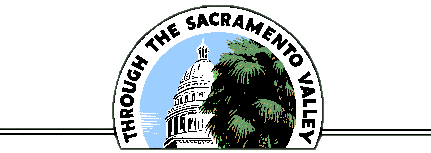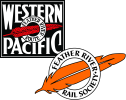SUBSTATIONS OF THE SACRAMENTO NORTHERN
Often overlooked by railfans and historians, substations were an essential part of an interurban railroad like the Sacramento Northern. How they worked, and their design variations, makes SN's substations worthy of study.
An interurban railway substation had two important jobs. The first was to reduce high voltage power to a level and type that could be used by car motors, and to feed that power into the distribution system. On the SN and its predecessors, high voltage AC power was purchased from Pacific Gas & Electric Company or Great Western Power Company. The substation reduced and converted this power to 600, 1200, or 1500 volts DC, then fed it into the distribution system, that is, the overhead wire or third rail.
A substation's second function was to maintain the voltage at a proper operating level, correcting for both loss due to normal resistance in the circuits and the draw from motors on cars or locomotives. This was accomplished by a human operator monitoring the current through meters, or later by automatic sensors, either of which turned on the substation equipment when the voltage drop reached a critical level. See Bob Campbell's story, ALL ABOUT SN'S CONCORD SUBSTATION, for a more detailed explanation.

Interurban substations were built with one of three types of equipment: rotary convertors, motor-generators, or mercury-arc rectifiers. The SN used all three types. Motor-generator sets were the most common in the early years, but were later replaced by rotary convertors . As noted above, substations could be manual or automatic. In the early years, all Northern Electric Railway and Oakland, Antioch & Eastern Railway substations were manual, but most were later converted to automatic operation by the SNRR and SNRY.
NERY / SNRR SUBSTATIONS
The first North End substation was actually installed by the Chico Electric Railway in 1904 on the grounds of the Diamond Match Co. plant at Barber (just outside Chico). After the streetcar line was taken over by the NERY, the substation equipment was moved to the new shops at Mulberry, probably in late 1906. It first occupied a 40 X 40-foot room within the car barn. Later the equipment was moved to a separate building.
The equipment used at Mulberry was the standard design for all original NERY substations, a Westinghouse two-bearing motor-generator set. This consisted of a 400 kilowatt, 600 volt DC multipolar compound-wound generator turning at 500 rpm. The generator was driven by a three-phase 2200 volt, 60 cycle induction motor, which was mounted on the same base and connected to the generator by a shaft. The Mulberry installation actually consisted of two such units, as did the substations at Marysville (PG&E owned), Tres Vias and East Nicolaus. The panels and controls were built by General Electric.
An interesting sidelight, black Monson slate was specified for the switch panels in some NE substations. Monson slate came from underground quarries at Monson, Maine, and would have been carried over the famous 2-foot gauge Monson Railroad.
The original mainline NERY substations were numbered and located from north to south as follows: #1, Mulberry; #2, Esquon; #3, Tres Vias (later named Oroville Junction); #4, Boga (later named East Gridley); #5, Encinal; # 6, Marysville (PG&E); #8, East Nicolaus; #9, Riego (later renamed or moved to Ardmore); and #10, Sacramento (PG&E). Additional substations were located on the Oroville Branch at Oroville; on the Colusa Branch at Stohlman (#5A), plus feed from a PG&E substation at Colusa; and on the Woodland Branch at Elkhorn (#10A), with an additional feed from the PG&E at Woodland. Several apparently unnumbered substations were later added: Plumas (between Marysville and East Nicolaus), Pleasant Grove (between East Nicolaus and Riego), and Del Paso (between Riego and Sacramento). The isolated Vallejo & Northern (later the Vacaville branch) was served by a PG&E feed at Armijo where the line crossed the Cement, Tolenas & Tidewater Railway. The actual substation was at Cement on the CT&T, one mile north of the crossing.
Most NERY substations were housed in simple corrugated metal sheds, such as Tres Vias and Del Paso. Chico and East Nicolaus were exceptions, being robust poured concrete buildings.
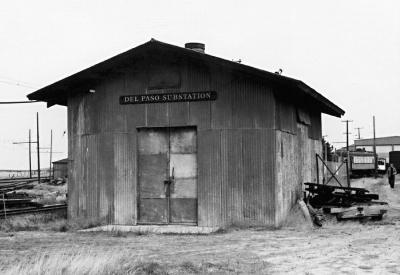
The original distance between NERY substations was approximately 10 miles, although there were some sections where the gap was more, the longest on the mainline being 16 1/2 miles between Marysville and East Nicolaus. Experience showed these gaps caused
slooooow
operation, especially when more than one train was running, so additional substations were plugged into these sections to boost the power and maintain scheduled speeds. Even so, operating rules required freight locomotives meeting or being passed by passenger trains or other freights to take a siding 20 minutes before the meet. The freight was required to wait an additional 20 minutes before starting up, to give the other train enough time to reach operating speed. Most mainline freight trains were scheduled to run at night to minimize meets and passes.
The NERY was a big fan of portable substations, and built a total of six over the years. Boxcar-type bodies for the substations were built on 40-foot long Fitzhugh-Luther flatcars in Chico shops. The cars were given new numbers as rolling stock which in no way corresponded to their location numbers. References to the substations in surviving documents often jump between original car numbers, substation car numbers, and location numbers, causing many headaches for historians. Despite being portable, these cars were permanently sited on the main line at Riego (NERY 1), Encinal (NERY 2) and Esquon (NERY 4). As the branches were built, two more cars were added for Stohlman on the Colusa Branch (NERY 5), and Elkhorn on the Woodland Branch (NERY 3, sometimes referred to as "Sacramento & Woodland 3"). A final portable substation (presumably NERY 6, though available records give no number) was built for Plumas around 1916. Most portables were accompanied by a companion car which held the transformers (and also had their own numbers, adding to the confusion). Eventually all the electrical equipment was moved into permanent structures and the cars destroyed or put to other uses, a process that took years due to NERY's 1914 bankruptcy. The substation at Riego/Ardmore was still listed as a grounded car in the 1928 SNRY valuation papers, apparently the last to be replaced by a permanent structure.

In early 1920, the new Sacramento Northern Railroad added another 600 volt portable substation, christened SNRR 1. The car was said to be the first automatic portable substation on any interurban railroad in the United States. Unlike earlier NERY substations, this unit contained a General Electric 300 kilowatt, 6-phase rotary convertor. The equipment was housed in a wooden 40-foot boxcar-type body, though again the car was based on a Fitzhugh-Luther flatcar. SNRR 1 was intended from the beginning to be a true portable, serving only temporarily where needed. Its first assignment was at Del Paso. With the great merger of 1929 the car became SNRY 1. Surviving photos suggest the car spent most of the 1930s stored unused outside the Mulberry Shops. Between January and April 1951, SNRY 1 was at Concord for conversion to manual operation. With the SN shops at Chico now closed, SNRY 1 was set up at the Western Pacific shops in Sacramento, probably in late April 1951. Until 1965 it powered two short tracks upon which the remaining electric locomotives were repaired and tested.
OA&E / SF-S SUBSTATIONS
The Oakland, Antioch & Eastern initially owned just five substations, plus one added by the San Francisco-Sacramento Railroad in 1924. The business end of these substations were 11,000 volt AC, 60 cycle, 514 rpm, 3-phase synchronous motors of 1080 horsepower. The motors powered 1200 volt DC interpole generators at 750 kilowatts, plus 19 kilowatt, 125 volt exciters, all on one shaft. All were single units, except for a paired substation at Eastport which boosted power on the 4.6 percent eastbound grade through the Oakland Hills. Unlike the NERY units which used magnetic switches, all OA&E substations were equipped with electro-pneumatic spring switches. These required an air compressor to operate.
Great Western Power Company supplied raw power to the OA&E at 11,000 volts AC. Later PG&E took over Great Western and continued to supply power to the SNRY.
In addition to Eastport (#1), substations were located at Lafayette (unnumbered, and added by the SF-S in 1924); #2, Concord; #3, Drawbridge (sometimes called Dutton); #4, Dozier; and #5 Lisbon. The operator at Drawbridge was also responsible for opening the bridge across Montezuma Slough. The Dozier substation also powered the short-lived Dixon Branch between 1914 and 1917.
Like substations on the North End, most of the former OA&E substations were simple corrugated iron sheds. The one exception was Concord, a substantial poured concrete building.
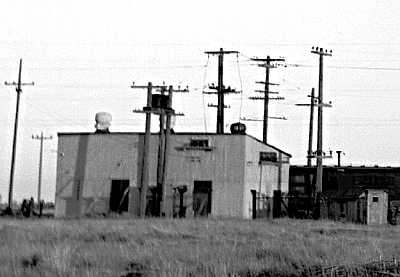
The OA&E had only one portable substation that can be identified in surviving records (in SACRAMENTO NORTHERN, Swett claims there were two). The known car was converted from boxcar 3005, probably around 1916. No new number is given for this car. This substation had a 350 kilowatt capacity at 1200 volts DC. There is some slim evidence that this or another portable may have served Concord during the 1920s, but at present this cannot be confirmed. The portable was eventually grounded as a permanent unit within the Oakland shops and fed the west end of the 1200 volt overhead which began at 42nd and Shafter Avenues in Oakland. Voltage for OA&E's 40th & Shafter yard was always set at 600 volts.
CHANGES AND IMPROVEMENTS
The success of SNRR's portable No. 1 encouraged the line to automate other North End substations. Two were converted in 1923, and a third in 1927. According to Swett, the rest were automated in 1929. An exception was Esquon, which retained an operator who monitored the system from there, and if needed, could turn on adjacent substations by remote control before their automatic sensors came on. Esquon was also a "live feed" location, which was always dumping 600 volt DC power into the system (another "live feed" was at Sacramento). North End power distribution was not sectionalized, so a train moving anywhere north of Sacramento drew down power over the entire system. Three or four substations might be running at one time for a single train.
By 1928, the SNRR had replaced nearly all the motor-generator sets with 6-phase rotary convertors. Only Ardmore and Esquon retained motor-generators at that time.
Local trackage at Oroville was isolated when floods cut the branch in 1937. The Oroville substation then reverted to manual control, and an operator was again assigned. When electric operation at Oroville ended on April 15, 1954, both the operator and station retired together.
South End substations were automated by 1929, with the exception of Drawbridge. Since an operator was needed to open the bridge, there was no advantage in automating this substation. Like the operator at Esquon, the man at Drawbridge could turn on adjacent substations at Lisbon and Dozier by remote control. No South End substations are known to have been replaced with rotary convertors.
The wire between Westgate (West Sacramento) and 42nd Street in Oakland and was divided into sections, which were powered from a continuous feeder cable strung on poles alongside the right-of-way. Between Mallard and Chipps, the cable was laid on the floor of the estuary. The cable allowed much more flexible operation than on lines north of Sacramento. One section at a time could be shut down for maintenance, rather than bringing down the entire system at once.
A new substation was added at Valdez on the Holland Branch in 1929. This automatic substation was powered by a mercury-arc rectifier, the only such unit on the SN system. Valdez was in the middle of nowhere, which was blessing since the rectifier required a forced mechanical cooling system that made a great deal of noise when operating. The rectifier also produced a strong blue glow which lit up the building at night. The Holland Branch was set at 1500 volts, the first time this pressure was used on the SN. The Valdez substation was a poured concrete building.
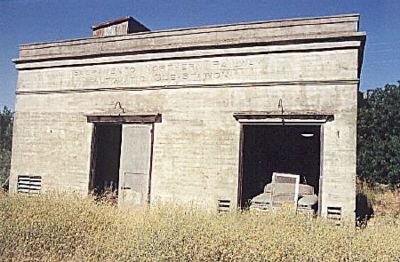
When the isolated Fairfield-Vacaville branch was finally tied to the mainline in 1930, power was supplied by the Dozier substation for the new 1200 volt section between Creede and Vacaville Junction. The original part of the branch continued to use 600 volts, purchased as before from PG&E.
In 1936, pressure on all the 1200 volt lines south of Sacramento was stepped up to 1500 volts and all the substations were modified. Shims were added to the field pole pieces to decrease the air gap between the field poles and armature poles on the DC generators. Higher voltage decreased line losses due to resistance, and also provided a modest increase in horsepower at the wheel of each train, with an corresponding increase in speed.

In April 1938, the SNRY built its second and last portable substation, SNRY 2. This was another automatic 600 volt rotary convertor machine, similar to SNRY 1. The new substation was housed in former SNRR automobile car 2100. The car was 36 feet long, had double side doors over a 10-foot, 2-inch opening, and rode on a steel underframe. As a substation, the car spent nearly all its life inside the Oakland shops powering 600 volt wire used in the 40th and Shafter yard.
THE END OF ELECTRIFICATION AND BEYOND
As the SNRY dieselized various sections, the substations were closed and the equipment sold as surplus or scrapped. Most North End subtations were dismantled by 1947. Stohlman was an exception, as power to open the Colusa drawbridge was drawn off the third rail running between the bridge and the substation. A gasoline generator at the bridge replaced the substation around 1948. PG&E's Marysville substation continued to serve the final electric operation between Marysville and Yuba City until dieselization in 1965.
Electric operation north of the ferry landing at Chipps Island ended July 1, 1953. On that date, the Drawbridge substation was closed. The operator was retained briefly to operate the drawbridge, though this apparently ended in 1954 when the ferry Ramon was taken out of service and the track was cut back to Montezuma. The Lafayette substation reverted to manual operation to provide a live operator, who could also control the Eastport and Concord substations. Lafayette also became the site of the "live feed". All South End electric service ended on February 28, 1957, and the substations were soon dismantled.
Just as the SNRY itself has disappeared, nearly all trace of the substations has also vanished. The substantial concrete building at East Nicolaus was still standing as late as 1972, with embossed Northern Electric heralds proclaiming its history. It has since been razed. Equipment from the Del Paso substation was sold to the Orange Empire Railway Museum, and now serves as their back-up power source, housed in a restored 1920s gas station. Del Paso's metal shed is at the Western Railway Museum, covering more modern equipment formerly used on the Bay Area Rapid Transit District's Concord test track. The WRM also uses portable SNRY 1, donated by the railroad when electric operation ended in 1965. The only known surviving South End structure is the concrete building that once covered the Valdez substation. It stands forlorn and abandoned in the Sacramento Delta, with a rusting farm truck for company.
